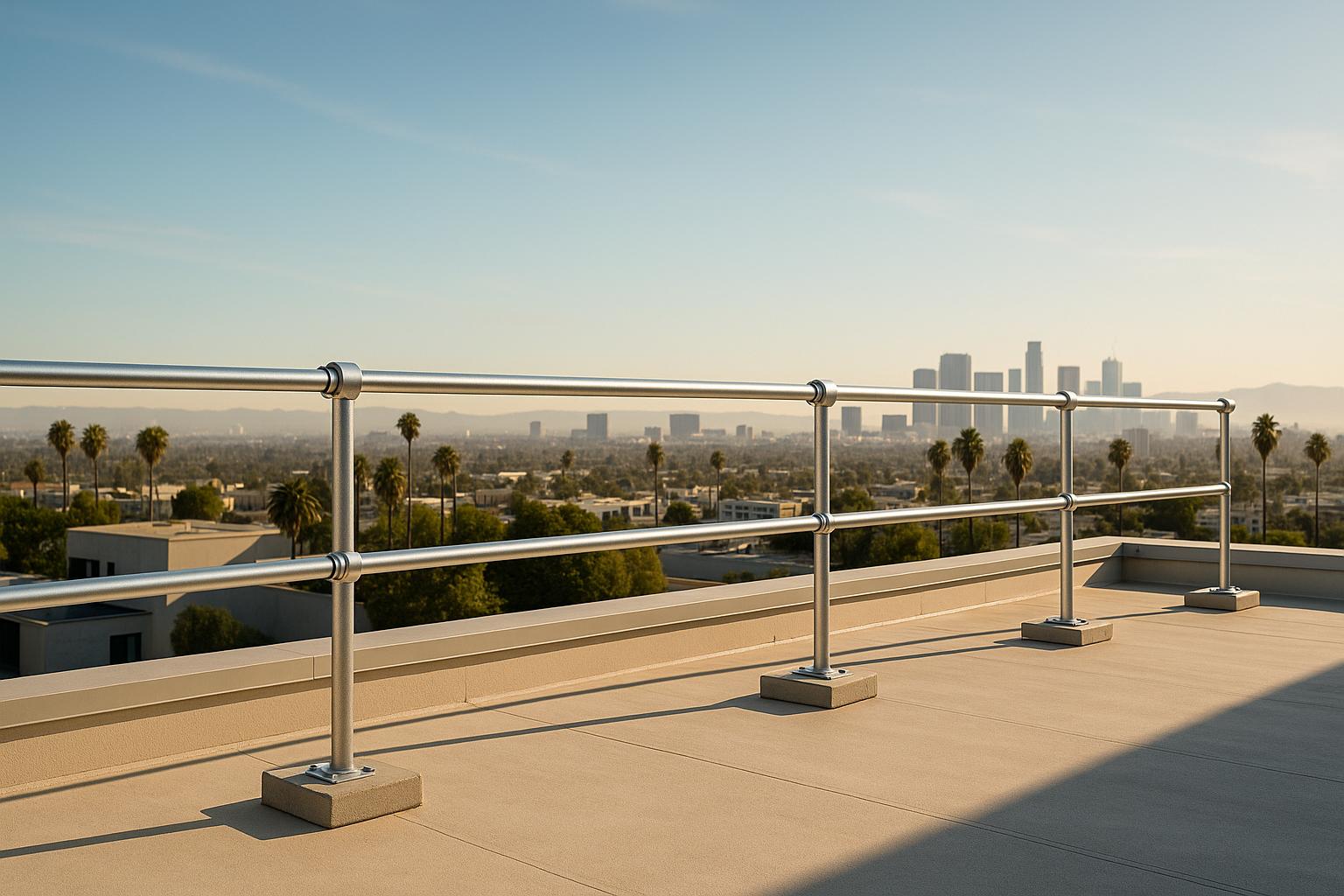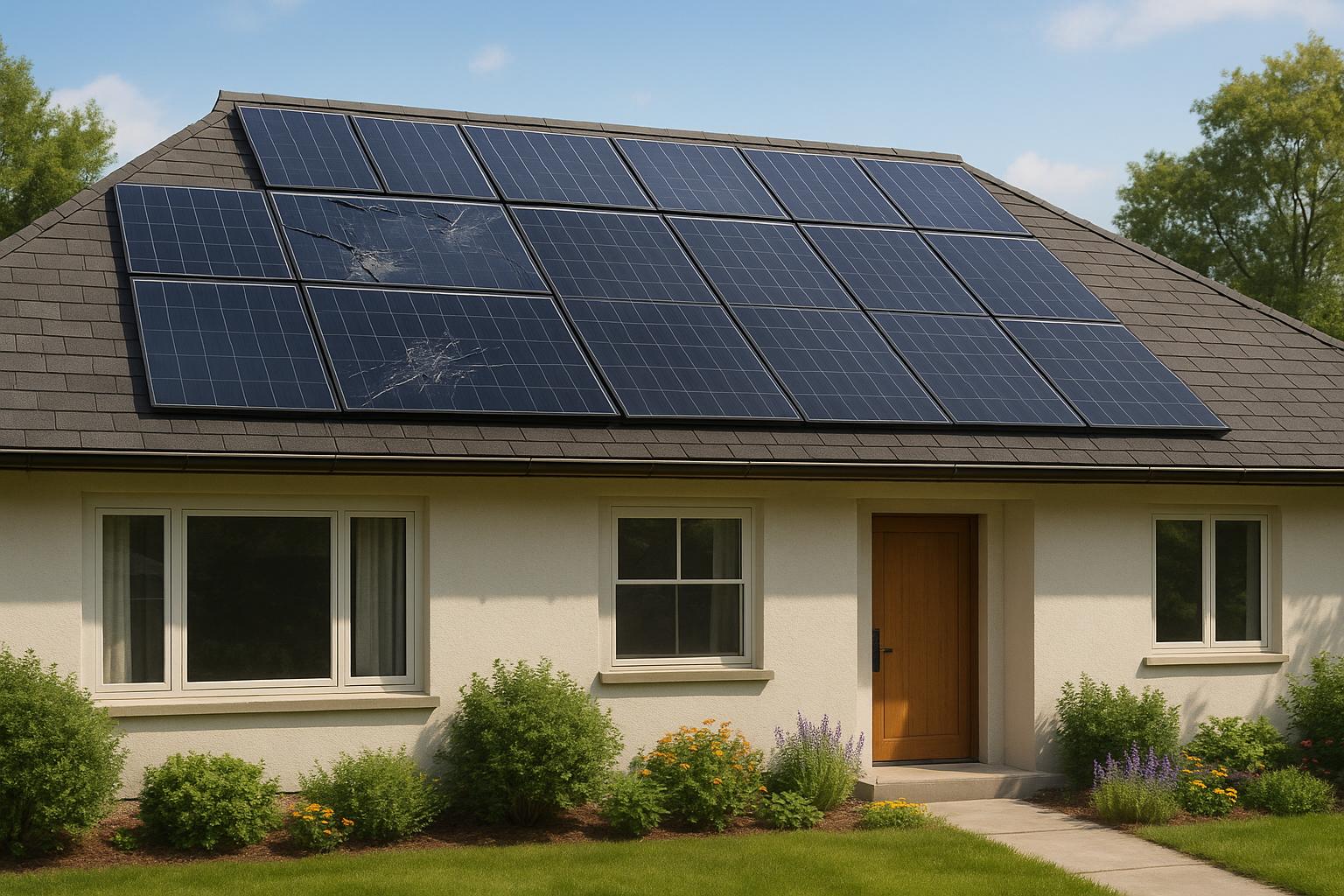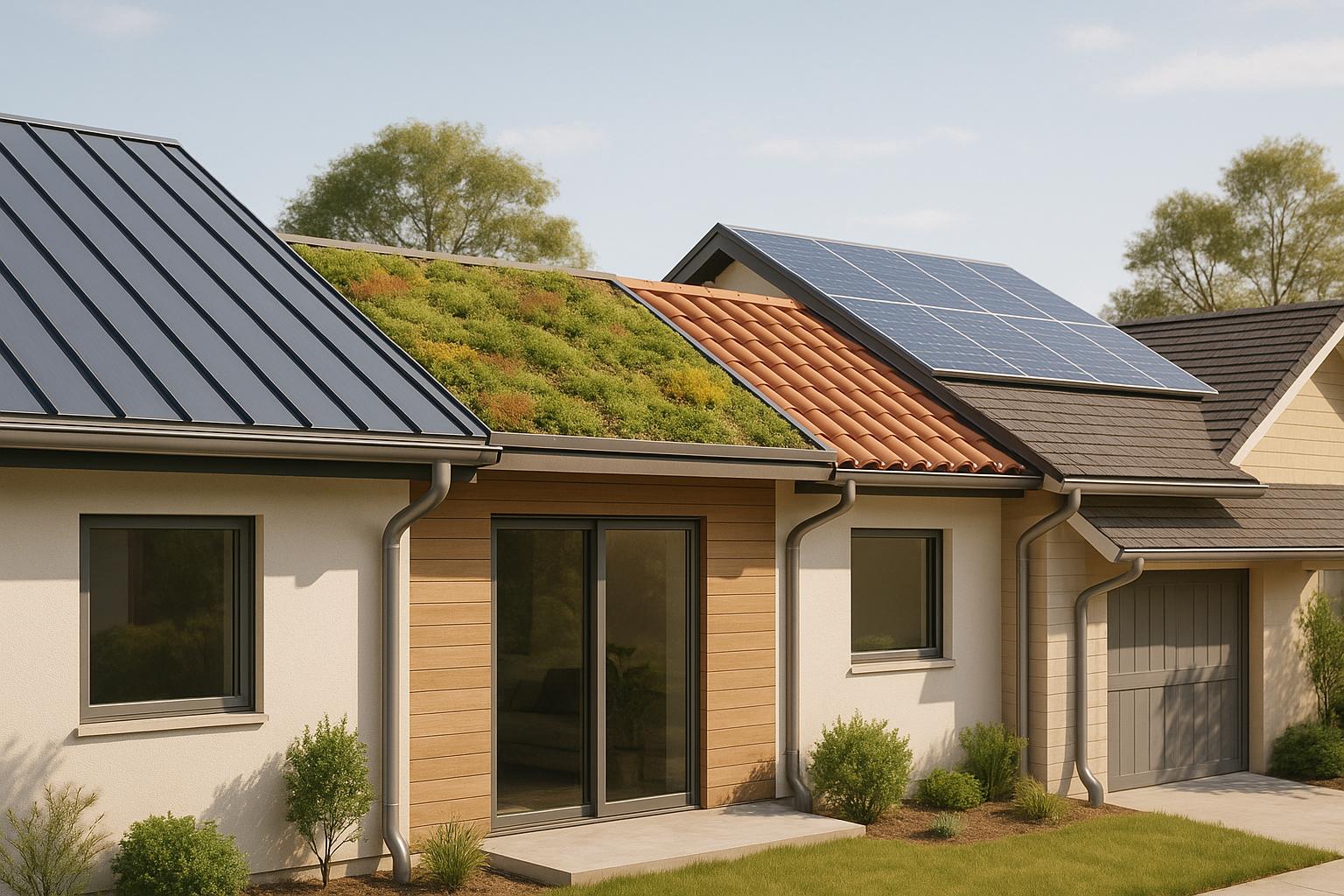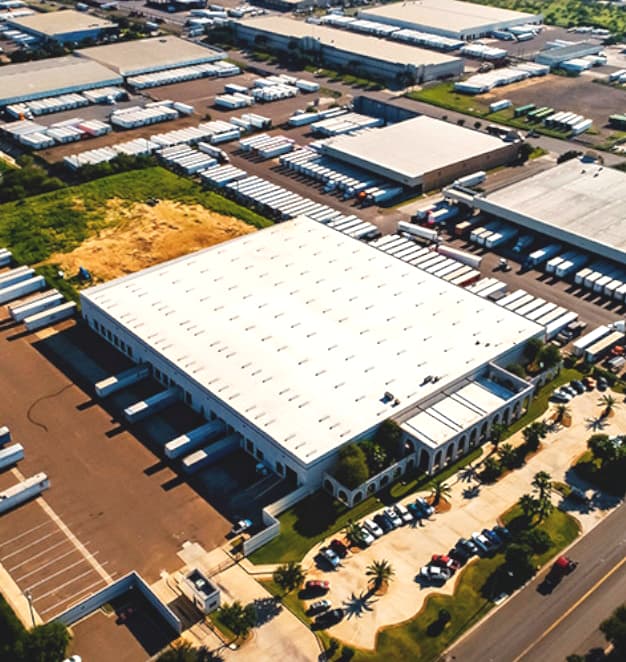Rooftop safety is critical, and California follows strict OSHA and Cal-OSHA rules to prevent falls and protect workers. Here’s what you need to know:
- Guardrails are required around open edges, work areas, equipment zones, access points, and skylights.
- Specifications include:
- Top rails at 42 inches (±3 inches)
- Mid rails at 21 inches above the surface
- Toeboards at least 4 inches high
- Post spacing no more than 8 feet apart
- Low-slope roofs need guardrails if over 7.5 feet high, while steep roofs require guardrails for regular access regardless of height.
- Cal-OSHA vs. OSHA: California’s rules are stricter, requiring engineering reviews, regular inspections, and adjustments for local conditions like high winds and seismic activity.
Regular inspections and professional installations are key to staying compliant and safe.
What are OSHA‘s Guardrail Requirements?
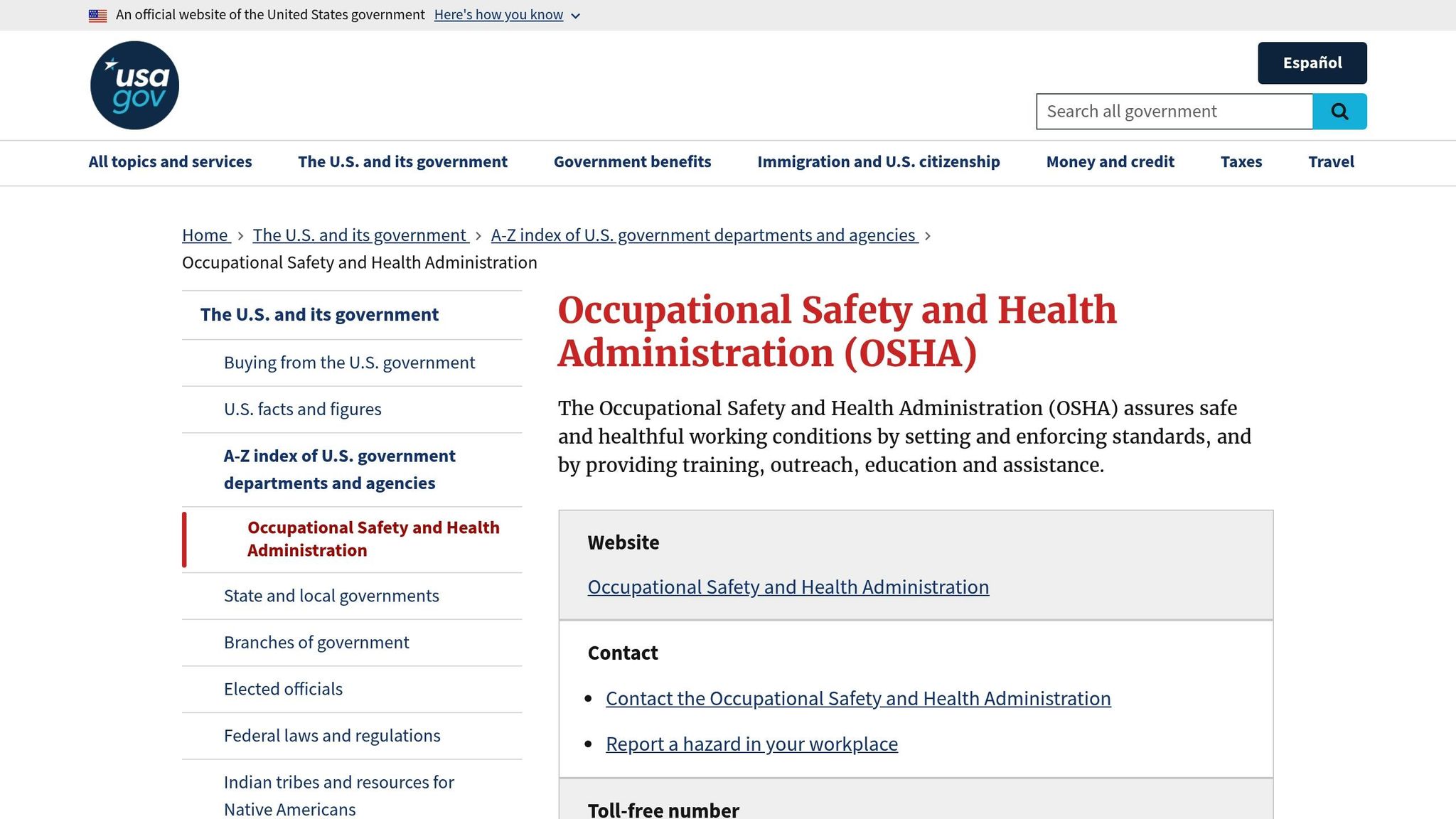
California Rooftop Guardrail Standards
California’s rooftop safety rules combine federal OSHA standards with Cal-OSHA requirements to ensure the safety of workers and building occupants. These regulations set clear guidelines for installing and maintaining rooftop guardrails.
Where Guardrails Are Required
Guardrails must be installed in these rooftop areas:
- Open Roof Edges: Any unprotected edges
- Work Areas: Locations where maintenance or similar tasks are performed
- Equipment Zones: Around HVAC units, solar panels, or other rooftop equipment
- Access Points: Entry and exit areas, like ladder access points
- Skylights: Around roof openings to prevent falls
Height and Design Specifications
Guardrails must meet the following standards:
| Component | Specification |
|---|---|
| Top Rail Height | 42 inches (±3 inches) |
| Mid Rail | Positioned 21 inches above the surface |
| Toeboard Height | At least 4 inches |
| Post Spacing | No more than 8 feet apart |
| Surface Clearance | No more than 19 inches between rails |
The system must also support at least 200 pounds of force applied outward or downward on the top rail.
Rules for Roof Slope and Height
-
Low-Slope Roofs (4:12 slope or less):
- Guardrails are required if the roof height exceeds 7.5 feet.
- Warning lines should be placed about 6 feet from the edge to alert workers.
- Full perimeter protection is recommended for areas with frequent foot traffic.
-
Steep Roofs (greater than 4:12 slope):
- Guardrails are mandatory for roofs with regular access, regardless of height.
- For roofs with a slope greater than 7:12, additional fall protection may be needed.
The next section will cover the specific components and installation practices required to comply with these regulations.
Building and Installing Guardrails
Key Components of a Guardrail System
To meet OSHA and Cal-OSHA standards for strength and stability, rooftop guardrail systems must include the following:
- Top rails: Act as the primary barrier to prevent falls.
- Mid rails: Provide additional protection by filling gaps below the top rail.
- Support posts: Form the structural backbone of the system.
- Toeboards: Prevent tools or other objects from falling off the roof.
- Mounting bases and fasteners: Ensure the system is securely attached to the roof.
All components should be made from strong, weather-resistant materials to withstand outdoor conditions.
Strength Requirements
Guardrails must be designed to handle the forces specified by OSHA and Cal-OSHA. This includes both everyday use and environmental factors like temperature shifts and weather exposure.
Installation Steps
-
Prepare the Site
Evaluate the roof to locate secure mounting points and confirm it can handle the load of the guardrail system. -
Install the Mounting Bases
Securely attach the mounting bases using fasteners that match the roof’s material and construction. -
Assemble the Guardrail
Connect the posts, rails, and other components, ensuring proper alignment and spacing. -
Inspect the Installation
Perform a thorough check to make sure everything is securely attached, aligned correctly, and free of hazards.
These steps provide the foundation for understanding how OSHA and Cal-OSHA requirements differ, which will be covered in the next section.
sbb-itb-d1d6490
OSHA vs Cal-OSHA Rules
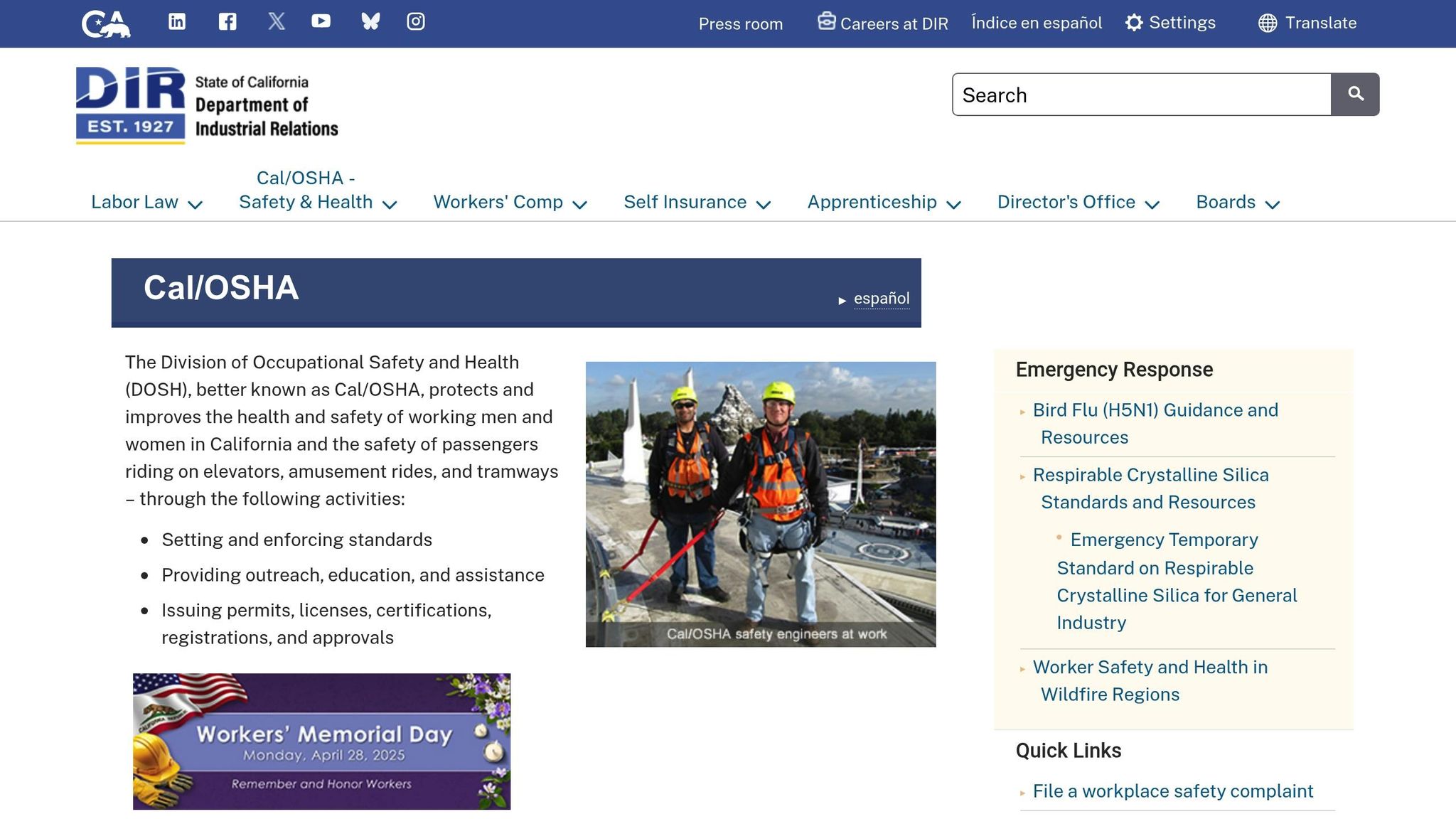
Cal-OSHA sets stricter standards than federal OSHA, particularly when it comes to rooftop guardrails. While both aim to prevent falls and protect workers, Cal-OSHA places extra focus on installation procedures, detailed documentation, and adjustments to suit California’s specific conditions.
Here are some key differences:
- Engineering reviews: Custom systems require thorough evaluations by qualified engineers.
- Inspection requirements: Cal-OSHA mandates regular inspections with formal documentation.
- Local conditions: Rules account for factors like high winds, seismic activity, and material durability in California’s climate.
These stricter measures are designed to ensure rooftop guardrails remain dependable over time, even under challenging conditions. Contractors and property owners must stay updated on Cal-OSHA’s latest guidelines to remain compliant and maintain safety standards.
Property Type Requirements
OSHA and Cal-OSHA standards differ depending on the type of property, which directly impacts rooftop guardrail requirements.
Home vs. Business Requirements
Commercial properties must meet stricter standards due to higher rooftop activity. These buildings often require measures like full perimeter guardrails and restricted access. Residential properties, on the other hand, focus on protecting areas that homeowners can easily access. For mixed-use developments, commercial standards typically apply to business areas, while residential sections follow tailored guidelines. Always check OSHA and Cal-OSHA regulations to ensure your property meets the necessary requirements.
Routine Safety Inspections
Regular inspections are key to maintaining both your roof’s condition and the effectiveness of guardrails. Scheduling annual checks helps identify potential issues early, ensuring the guardrails remain reliable over time.
Services From Prime American Roofing
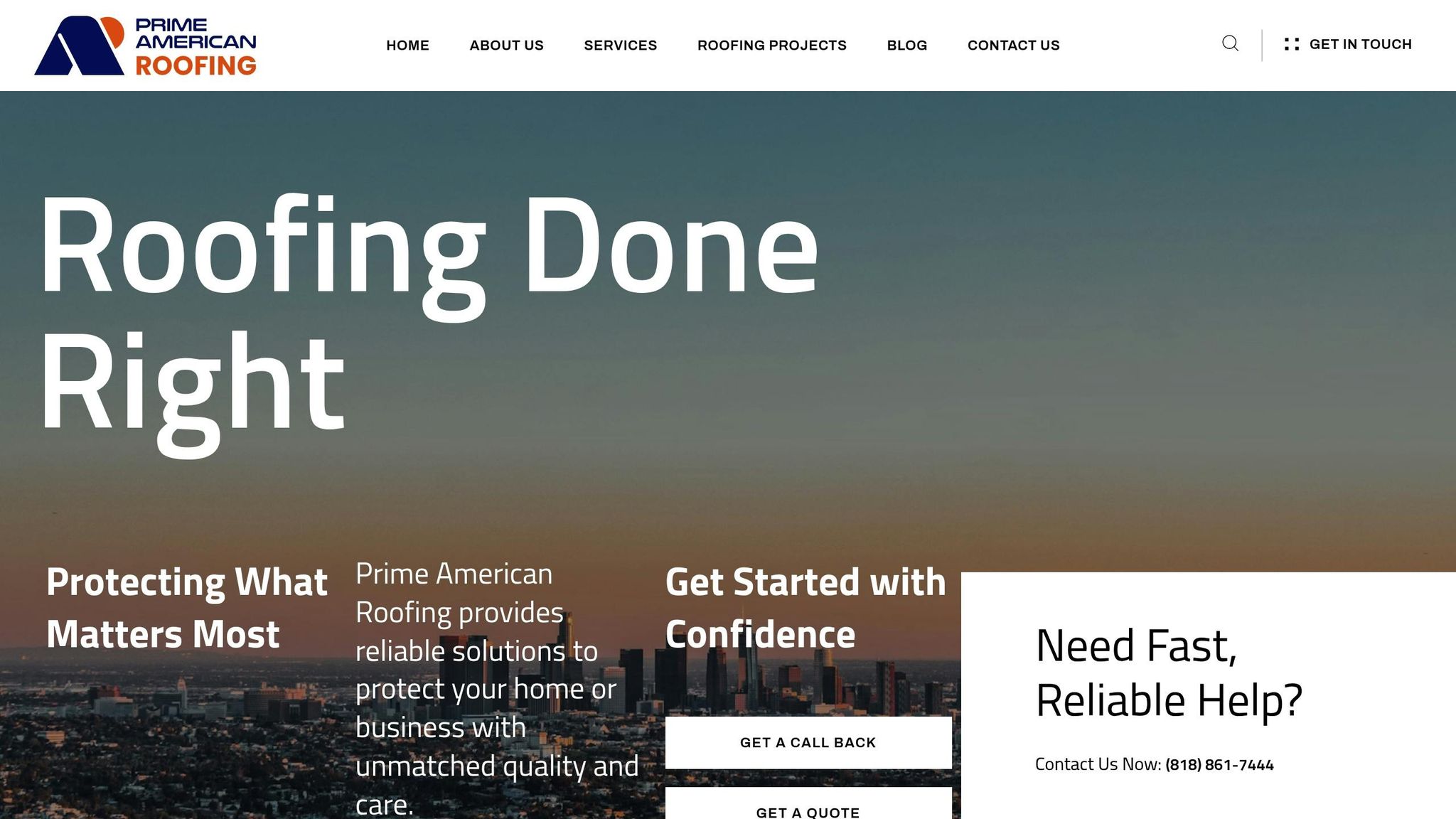
Prime American Roofing provides thorough roof inspections and maintenance services to help both commercial and residential properties stay compliant with OSHA standards.
Summary
OSHA and Cal-OSHA guardrail standards are designed to prevent falls and help property owners avoid legal troubles. These regulations differ depending on the type of property: commercial rooftops typically require full-width guardrails, while residential systems prioritize accessible safety measures. Following these standards not only reduces fall risks but also keeps you in compliance with the law.
Keeping guardrails effective requires regular upkeep. Here are the essentials:
- Height Requirements: Ensure guardrails meet the minimum height standards for your property type.
- Proper Installation: Follow specific guidelines based on roof slope and property use.
- Ongoing Maintenance: Perform routine safety checks to address wear and tear.
- Expert Inspections: Schedule professional evaluations to confirm compliance with safety rules.
For property owners looking to maintain compliant and secure rooftop guardrails, Prime American Roofing offers inspection and installation services. Their team can evaluate your current setup, suggest necessary upgrades, and implement safety measures that align with OSHA and Cal-OSHA regulations, ensuring your property stays both safe and up to code.
FAQs
What are the key differences between OSHA and Cal/OSHA rooftop guardrail regulations in California?
OSHA (Occupational Safety and Health Administration) sets federal standards for workplace safety, including rooftop guardrail requirements. Cal/OSHA, California’s state-level equivalent, enforces these federal standards but may also implement additional or stricter regulations specific to California. For example, Cal/OSHA often tailors its rules to address the unique environmental and industry conditions in the state.
In general, both OSHA and Cal/OSHA require rooftop guardrails to meet specific height, strength, and installation criteria to protect workers from fall hazards. However, always refer to Cal/OSHA guidelines for the most accurate and up-to-date compliance requirements for properties in California. Ensuring compliance is crucial for both residential and commercial roofing projects to avoid penalties and maintain workplace safety.
What steps can property owners take to keep rooftop guardrails compliant with OSHA safety standards in California?
To keep rooftop guardrails compliant with OSHA safety standards, property owners should prioritize regular inspections and maintenance. Schedule professional roof inspections at least once a year to identify and address any issues that may affect compliance. It’s also essential to check for wear, damage, or structural changes after severe weather or significant rooftop work.
By staying proactive about maintenance, you can ensure the safety of anyone accessing your roof while meeting OSHA requirements for both residential and commercial properties in California.
What should you consider when installing guardrails on steep or low-slope roofs?
When installing guardrails on roofs, the slope of the roof plays a crucial role in determining the appropriate safety measures. For steep roofs (those with a slope greater than 4:12), guardrails must be designed to prevent falls from higher angles, often requiring additional bracing or higher railings. On low-slope roofs (4:12 or less), guardrails should be positioned to cover all open edges and may include toe boards to prevent tools or materials from falling.
In California, OSHA standards mandate that guardrails meet specific height and strength requirements, regardless of the roof type. Always ensure compliance with OSHA guidelines to protect workers and avoid penalties. For expert installation or roofing solutions, consider working with professionals experienced in safety compliance and durable materials.

